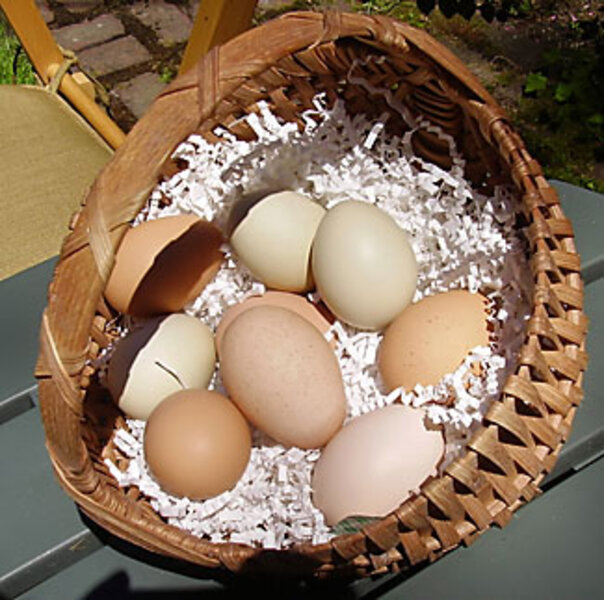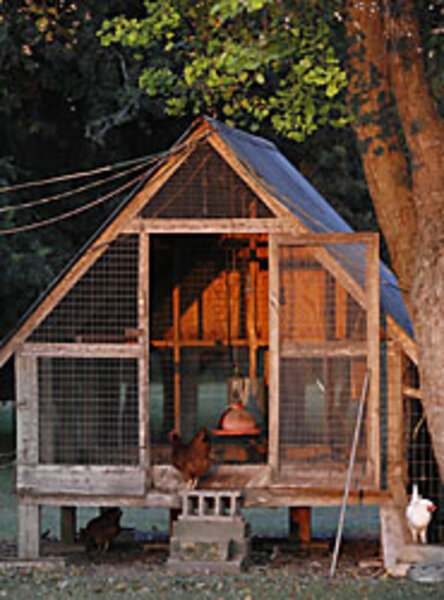Whole lotta clucking going on in cities
Loading...
When Meg Taylor and her husband went house hunting last fall in Northampton, Mass., the couple passed on several properties that weren't set up just right for their "girls."
Those girls are hens: Alice, Ester, Penelope, Petunia, Sophie, and Winifred. So the couple wanted a yard with an ample mix of sun and shade so the flock could soak in the rays, take dust baths, and nap under leafy trees.
After several weeks, they found the perfect place.
"Once you have chickens, it's really hard to live without them," says Ms. Taylor, a former biology teacher who's now a stay-at-home mom.
She and her husband, Andrew Gould, aren't the only ones who've discovered this. They're part of a growing nationwide trend – city dwellers raising poultry in backyards, mostly out of concern for where their food is coming from.
"You hear all these horror stories about factory farms, and you want a higher ethical standard for the food that you have," said Angelina Shell of the Seattle Tilth Association, a group that offers sustainable-living classes. Most chickens are kept for their eggs, she adds.
The communities of Fort Collins, Colo.; Ann Arbor, Mich.; and Wake Forest, N.C.; have passed laws allowing residents to keep a limited number of backyard birds. Other chicken-friendly cities include New York; Oakland, Calif.; Portland, Ore.; and Salt Lake City.
Fresh eggs for breakfast aren't the only benefit of raising chickens, say hobbyists. The birds provide organic fertilizer, and their appetite for pesky weeds and bugs helps gardens thrive.
"If our economy continues on the downward spiral," says Ms. Shell, a third-generation poultry hobbyist, "you're going to see a lot more people raising their own chickens in their backyards and starting up vegetable gardens."
Still, chickens aren't always popular with neighbors in city and suburban neighborhoods.
Chicago Alderman Lona Lane proposed a citywide chicken ban late last year after constituents bombarded her office with complaints about noise, odor, and rodents. But chicken enthusiasts from other parts of the Windy City cried fowl, stalling a final decision. After the holidays, Ms. Lane plans on introducing a new bill to ban chickens in just the neighborhood she represents.
In cities where chickens are legal, regulations usually limit the number of hens to three or four. Most prohibit roosters because of early-morning crowing, and slaughtering is strictly forbidden.
Some critics, in an effort to keep birds out of urban areas, raise concerns about avian influenza. But Michael Martin, a poultry veterinarian at North Carolina State University in Raleigh, doesn't believe there's any cause for concern.
"The risk of a human becoming exposed before we knew anything about any kind of poultry disease is pretty much nonexistent," he says.
In today's computer age, starting a flock is as simple as the click of a mouse. Chicks can be ordered online and delivered right to your door.
Annual "coop tours" in some cities educate chicken enthusiasts about enclosures (a necessity for keeping flocks safe from predators) by showcasing structures ranging from the fanciful to the practical.
Classes such as Seattle Tilth's "City Chickens 101" generally sell out months in advance. Interest has been so great this year that the group has offered nine classes, each with 35 to 45 people in attendance. Normally, only two or three classes are held each year.
An online plethora of poultry websites, blogs, and chat rooms exist, too.
Taylor, the house hunter, started a Yahoo group earlier this year as a way for chicken owners in western Massachusetts to share information. So far, about 70 people are members of the Pioneer Valley Backyard Chicken Association (http://pets.groups.yahoo.com/group/pvbca).
Taylor says that she's often surprised by how many people own chickens but keep it hush-hush because they're afraid the birds might not be legal where they live.
At a recent community fair that she attended with her pet chickens, dozens of people secretly confided in her that they also owned backyard poultry.
"They came up to me, kind of looked on either side of them, and said in a quiet voice: 'I've got a flock, too,' " she recalls with a laugh.
Many people are surprised to learn that not all chickens are plain white like the ones found on commercial farms. Hundreds of breeds exist in a dizzying array of sizes, shapes, colors, and patterns.
Some even lay light blue, olive green, or chocolate brown eggs.
In the 1800s, when what are called fancy poultry breeds were first introduced into the United States, people got so excited about raising them, they were said to have "hen fever."
Today we're starting to see that again, notes Francine Bradley, a poultry extension specialist at the University of California, Davis.
As part of her job, Dr. Bradley frequently gives advice to backyard hobbyists and parents whose kids bring home chicks hatched during school science projects.
"Owning a chicken is no different than owning a dog or cat," says Bradley. "If you're going to be the steward of an animal, you should know how to take care of it before you purchase one."
Cooperative Extension offices, located in every county nationwide, can provide novice chicken fanciers with reliable information on raising backyard flocks, she adds.
The biggest mistake Bradley sees first-time owners make is not feeding their pets properly.
"I often get people calling who can't figure out why their chicks look a little funny and aren't growing well, or why their hens haven't been laying eggs," she says. "Then I find out that they're feeding them only one thing: organic polenta. Organic or otherwise, cornmeal is not a balanced diet for a chicken."
Bradley recommends buying food especially formulated for chickens at a feed supply store. "We know more about the nutrition for chickens than any other living animal, including humans," she says, "so there's no excuse for not feeding a bird well."
Although keeping chickens in urban settings is gaining in popularity, a surprising number of people have done it for years.
In the 1970s, California officials attempted to figure out how many people owned backyard flocks. They decided to use feed sales at local stores as a gauge since commercial ranchers buy directly from feed mills.
"They were amazed at the amount of chicken feed sold within the city of San Francisco," recalls Bradley. "And if you go at the right time of day into any neighborhood in San Francisco [today], you can hear cocks crowing, so there are backyard chickens everywhere."






